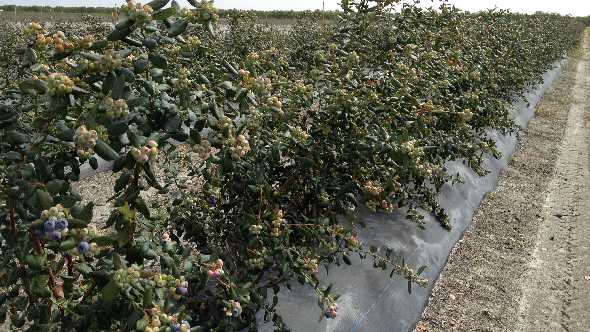Study Zeroes in on Sweet Spot for Florida Blueberries
On a mission to dig into flavor-fueled food trends, a team of researchers from the University of Florida and the Monell Chemical Senses Center in Pennsylvania set out with buckets of Florida blueberries to find how children and adults differ in the way they perceive sweetness of fructose – the main type of sugar in the fruit.

According to a new study, children find the sweet flavor of ‘Arcadia’ blueberries to be quite blissful.
Photo courtesy of UF/IFAS
By letting participants eat UF/IFAS-developed blueberries and thus measuring their sweet preferences, scientists discovered that children are more sensitive to slight variations in the sweetness of blueberries. In fact, children have a higher “bliss point” for the sweetness of fructose.
To get to this conclusion, UF/IFAS sent two harvests worth of blueberries to the Monell lab. For the study, 49 children and their mothers went to the Monell center to taste three blueberry varieties. Researchers wanted to distinguish participants’ preferences among three UF/IFAS cultivars — ‘Arcadia,’ ‘Keecrisp,’ and ‘Kestrel.’
Berries picked during the first harvest were similar in sugar content and children and their parents preferred ‘Keecrisp.’ For the second harvest, Arcadia had the higher sugar content. While mothers liked each cultivar equally, children preferred ‘Arcadia,’ showing how they are more sensitive to changes in sweetness, the study found.
Researchers also wanted to find the link between participants’ blueberry preferences and the level of natural sugar in the fruit, and they sought the most preferred level of fructose, one of the primary sugars in blueberry fruit.
According to researchers, this study shows that parents can be more judicious about what foods they buy their children, and growers can produce the fruit children want to eat. Furthermore, supermarkets can market fruit in terms of its palatability to kid consumers. “Children are consumers of fruit,” stated Linda Bartoshuk, a UF/IFAS Professor of food science and human nutrition and a co-author on the new study. “Parents buy fruit to give kids, so why not have the evaluations of kids to guide their selections?”
The study, which is published in the Journal of Food Science, marks the first in a series of collaborative projects from the Food and Flavor Division of the UF/IFAS Plant Innovation Center.
Consumption of blueberries in the U.S. has increased 15-fold over the past two decades, and the blueberry industry has undergone tremendous growth, reaching about $825 million in 2014, according to USDA statistics. Despite increasing blueberry consumption, the average American child ages 6 to 19 consumes far less fruit than the national goal of 1.5 cups per person per day. Mirroring the national trend, 73% of the children and 92% of adults who participated in this study did not meet guidelines for fruit intake.









